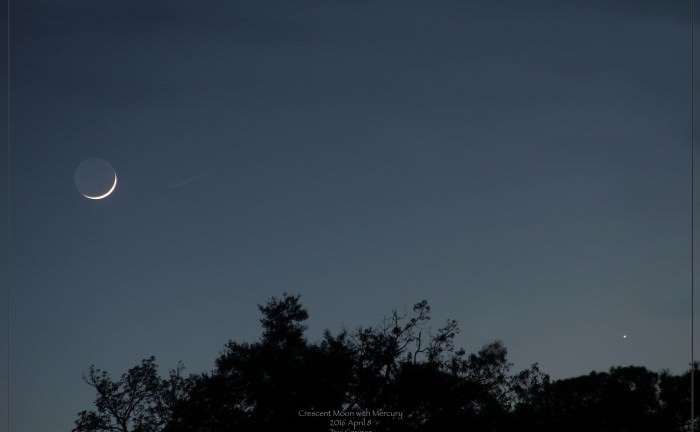Prelude to Transit: Catching Mercury Under Dusk Skies

Have you ever seen Mercury? The diminutive innermost world takes the center stage next month, as it transits the Sun as seen from our early perspective on May 9th. This week, we’d like to turn your attention to bashful Mercury’s dusk apparition, which sets up the clockwork celestial gears for this event.Why is April’s appearance of Mercury special? Well, this elongation is the second of six for 2016, and is the best dusk appearance for Mercury for northern hemisphere observers.Now, ranking the ‘best’ is a bit of an arcane affair, as not all apparitions of Mercury are created equal. First, Mercury’s orbit is elliptical, meaning it can venture anywhere from 17.9 to 27.8 degrees from the Sun as seen from the Earth. This means you’ll always find Mercury at its best visibility in the dawn or dusk skies. This also means that, while it reaches 50% illumination at greatest elongation—think of Earth, Mercury and the Sun forming a HUGE right triangle in space—its brightness can also vary significantly from one apparition to the next next greatest elongation, from magnitude -0.2 (elongation near perihelion) to +0.7 (elongation near aphelion). And finally, Mercury’s visibility is a matter of observer latitude. April sees the angle of the dusk ecliptic roughly perpendicular to the horizon, thrusting Mercury up out of the mirth for observers based along mid-northern latitudes.Phew! Got all that? OK, here are some key dates leading up to the May transit:April 15: Mercury at greatest latitude north of the ecliptic (+7.0 degrees).April 18: Mercury reaches greatest elongation.April 28: Mercury 6.8 passes degrees SSW of the Pleiades.April 29: Mercury stationary; begins retrograde motion.May 9th: Transit!Mercury reaches greatest elongation six times in 2016. A great place to explore apparitions of Mercury over time is Formilab’s Mercury Chaser’s Calculator.Observing and ImagingMercury reaches magnitude +0.5, and appears 7” in size on April 15th. Mercury ends the month of April at magnitude +3.7 as a 11” diameter, 8% illuminated crescent. A good way to to find Mercury this week is to imagine it forming a large right triangle with Aldebaran and Capella, both 30 degrees away.At the telescope, Mercury will show a tiny half to crescent phase, mimicking the Moon. The heavy airmass low to the horizon will cause Mercury to shimmer and dance, making seeing cruddy (a technical term!) and picking out surface detail next to impossible. We knew little about Mercury right up until the Space Age. As a child of the 1970s, I remember how you could still find astronomy books quoting a wild range of rotation periods.Exploring Mercury, Near and FarToday, we know Mercury spins on its axis once every 58.6 Earth days. This is a 2:3 resonance with the Mercurial ‘year,’ and from certain locales on the surface, you would actually see the Sun rise, reverse direction, and set again! Mercury also resembles our own Moon, minus the maria.To date, only NASA has visited Mercury, first during the three Mariner 10 flybys in 1974 and 1975, and with Mercury MESSENGER, which became the only human-built spacecraft to orbit around Mercury after three flybys starting on March 18th, 2011. Messenger also holds the distinction of being the only human artifact to touch Mercury, crashing into the planet on April 30th, 2015. The European Space Agency will carry on the legacy of Mercury exploration, with the launch of its BepiColombo spacecraft in January of next year. BepiColombo will enter orbit around Mercury on New Year’s Day, 2024.And the orbit of Mercury played a key role in 20th century science. Namely, the anomalous precession of its perihelion could not be explained away by Newtonian mechanics. This led to the prediction of a world dubbed Vulcan on an orbit interior to Mercury’s own. Spurious sightings of Vulcan persisted, and the world even made the list of solar system planets through the end of the 19th century… but it took Einstein’s theory of general relativity to do away with the need for Vulcan and explain the persistent advance of Mercury’s orbit.Follow that fleeting world, as Mercury will transit the face of the Sun as seen from the Earth on May 9th. This is one of only 14 transits of Mercury for the 21st century. The last occurred on November 8th, 2006, and the next is on November 11th, 2019. We remember courting heat stroke during the 2006 transit, as we supported public viewing from the lawn surrounding the Flandrau observatory on the Tucson, Arizona campus. Mercury enters the field of view of the Solar Heliospheric Observatory’s (SOHO) LASCO C3 camera on May 4th leading up to the transit, and exits on May 14th, headed once again back in to the dawn sky.Bob King will have more out on the transit of Mercury for Universe Today very soon… watch this space!
The post Prelude to Transit: Catching Mercury Under Dusk Skies appeared first on Universe Today.